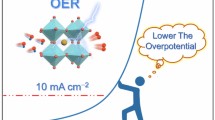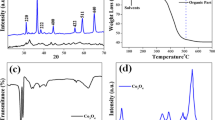Abstract
Nitrogen-doped graphene is a promising candidate for the replacement of noble metal-based electrocatalysts for oxygen reduction reactions (ORRs). The addition of pores and holes into nitrogen-doped graphene enhances the ORR activity by introducing abundant exposed edges, accelerating mass transfer, and impeding aggregation of the graphene sheets. Herein, we present a straightforward but effective strategy for generating porous holey nitrogen-doped graphene (PHNG) via the pyrolysis of urea and magnesium acetate tetrahydrate. Due to the combined effects of the in situ generated gases and MgO nanoparticles, the synthesized PHNGs featured not only numerous out-of-plane pores among the crumpled graphene sheets, but also interpenetrated nanoscale (5–15 nm) holes in the assembled graphene. Moreover, the nitrogen doping configurations of PHNG were optimized by post-thermal treatments at different temperatures. It was found that the overall content of pyridinic and quaternary nitrogen positively correlates with the ORR activity; in particular, pyridinic nitrogen generates the most desirable characteristics for the ORR. This work reveals new routes for the synthesis of PHNG-based materials and elucidates the contributions of various nitrogen species to ORRs.

Similar content being viewed by others
References
He, D. S.; He, D. P.; Wang, J.; Lin, Y.; Yin, P. Q.; Hong, X.; Wu, Y.; Li, Y. D. Ultrathin icosahedral Pt-enriched nanocage with excellent oxygen reduction reaction activity. J. Am. Chem. Soc. 2016, 138, 1494–1497.
Chen, S.; Bi, J. Y.; Zhao, Y.; Yang, L. J.; Zhang, C.; Ma, Y. W.; Wu, Q.; Wang, X. Z.; Hu, Z. Nitrogen-doped carbon nanocages as efficient metal-free electrocatalysts for oxygen reduction reaction. Adv. Mater. 2012, 24, 5593–5597.
Wang, S. Y.; Zhang, L. P.; Xia, Z. H.; Roy, A.; Chang, D. W.; Baek, J.-B.; Dai, L. M. BCN graphene as efficient metalfree electrocatalyst for the oxygen reduction reaction. Angew. Chem., Int. Ed. 2012, 51, 4209–4212.
Gong, Y. J.; Fei, H. L.; Zou, X. L.; Zhou, W.; Yang, S. B.; Ye, G. L.; Liu, Z.; Peng, Z. W.; Lou, J.; Vajtai, R. et al. Boron- and nitrogen-substituted graphene nanoribbons as efficient catalysts for oxygen reduction reaction. Chem. Mater. 2015, 27, 1181–1186.
Guo, Z. Y.; Xiao, Z.; Ren, G. Y.; Xiao, G. Z.; Zhu, Y.; Dai, L. M.; Jiang, L. Natural tea-leaf-derived, ternary-doped 3D porous carbon as a high-performance electrocatalyst for the oxygen reduction reaction. Nano Res. 2016, 9, 1244–1255.
Shi, Q.; Wang, Y. D.; Wang, Z. M.; Lei, Y. P.; Wang, B.; Wu, N.; Han, C.; Xie, S.; Gou, Y. Z. Three-dimensional (3D) interconnected networks fabricated via in-situ growth of N-doped graphene/carbon nanotubes on Co-containing carbon nanofibers for enhanced oxygen reduction. Nano Res. 2016, 9, 317–328.
Niu, W. H.; Li, L. G.; Liu, X. J.; Wang, N.; Liu, J.; Zhou, W. J.; Tang, Z. H.; Chen, S. W. Mesoporous N-doped carbons prepared with thermally removable nanoparticle templates: An efficient electrocatalyst for oxygen reduction reaction. J. Am. Chem. Soc. 2015, 137, 5555–5562.
Han, C. L.; Wang, S. P.; Wang, J.; Li, M. M.; Deng, J.; Li, H. R.; Wang, Y. Controlled synthesis of sustainable N-doped hollow core–mesoporous shell carbonaceous nanospheres from biomass. Nano Res. 2014, 7, 1809–1819.
Choi, C. H.; Park, S. H.; Woo, S. I. Binary and ternary doping of nitrogen, boron, and phosphorus into carbon for enhancing electrochemical oxygen reduction activity. ACS Nano 2012, 6, 7084–7091.
Liang, J.; Jiao, Y.; Jaroniec, M.; Qiao, S. Z. Sulfur and nitrogen dual-doped mesoporous graphene electrocatalyst for oxygen reduction with synergistically enhanced performance. Angew. Chem., Int. Ed. 2012, 51, 11496–11501.
Sheng, Z.-H.; Shao, L.; Chen, J.-J.; Bao, W.-J.; Wang, F.-B.; Xia, X.-H. Catalyst-free synthesis of nitrogen-doped graphene via thermal annealing graphite oxide with melamine and its excellent electrocatalysis. ACS Nano 2011, 5, 4350–4358.
Yu, L.; Pan, X. L.; Cao, X. M.; Hu, P.; Bao, X. H. Oxygen reduction reaction mechanism on nitrogen-doped graphene: A density functional theory study. J. Catal. 2011, 282, 183–190.
Xing, T.; Zheng, Y.; Li, L. H.; Cowie, B. C. C.; Gunzelmann, D.; Qiao, S. Z.; Huang, S. M.; Chen, Y. Observation of active sites for oxygen reduction reaction on nitrogen-doped multilayer graphene. ACS Nano 2014, 8, 6856–6862.
Zhang, H. Y.; Zhao, J. X.; Cai, Q. H. Pyridine derivative/ graphene nanoribbon composites as molecularly tunable heterogeneous electrocatalysts for the oxygen reduction reaction. Phys. Chem. Chem. Phys. 2016, 18, 5040–5047.
Guo, D. H.; Shibuya, R.; Akiba, C.; Saji, S.; Kondo, T.; Nakamura, J. Active sites of nitrogen-doped carbon materials for oxygen reduction reaction clarified using model catalysts. Science 2016, 351, 361–365.
Liang, H. W.; Zhuang, X. D.; Brüller, S.; Feng, X. L.; Müllen, K. Hierarchically porous carbons with optimized nitrogen doping as highly active electrocatalysts for oxygen reduction. Nat. Commun. 2014, 5, 4973–4979.
Zhang, C. Z.; Hao, R.; Liao, H. B.; Hou, Y. L. Synthesis of amino-functionalized graphene as metal-free catalyst and exploration of the roles of various nitrogen states in oxygen reduction reaction. Nano Energy 2013, 2, 88–97.
Bai, X. G.; Shi, Y. T.; Guo, J. H.; Gao, L. G.; Wang, K.; Du, Y.; Ma, T. L. Catalytic activities enhanced by abundant structural defects and balanced N distribution of N-doped graphene in oxygen reduction reaction. J. Power Sources 2016, 306, 85–91.
Chen, C. M.; Zhang, Q.; Huang, C. H.; Zhao, X. C.; Zhang, B. S.; Kong, Q. Q.; Wang, M. Z.; Yang, Y. G.; Cai, R.; Su, D. S. Macroporous “bubble” graphene film via templatedirected ordered-assembly for high rate supercapacitors. Chem. Commun. 2012, 48, 7149–7151.
Wang, Z. L.; Xu, D.; Wang, H. G.; Wu, Z.; Zhang, X. B. In situ fabrication of porous graphene electrodes for highperformance energy storage. ACS Nano 2013, 7, 2422–2430.
Zhao, C. T.; Yu, C.; Liu, S. H.; Yang, J.; Fan, X. M.; Huang, H. W.; Qiu, J. S. 3D porous N-doped graphene frameworks made of interconnected nanocages for ultrahigh-rate and long-life Li–O2 batteries. Adv. Funct. Mater. 2015, 25, 6913–6920.
Kim, H.; Lee, K.; Woo, S. I.; Jung, Y. On the mechanism of enhanced oxygen reduction reaction in nitrogen-doped graphene nanoribbons. Phys. Chem. Chem. Phys. 2011, 13, 17505–17510.
Zhang, L. P.; Niu, J. B.; Dai, L. M.; Xia, Z. H. Effect of microstructure of nitrogen-doped graphene on oxygen reduction activity in fuel cells. Langmuir 2012, 28, 7542–7550.
Lin, Y.; Han, X. G.; Campbell, C. J.; Kim, J. W.; Zhao, B.; Luo, W.; Dai, J. Q.; Hu, L. B.; Connell, J. W. Holey graphene nanomanufacturing: Structure, composition, and electrochemical properties. Adv. Funct. Mater. 2015, 25, 2920–2927.
Zhao, X.; Hayner, C. M.; Kung, M. C.; Kung, H. H. Flexible holey graphene paper electrodes with enhanced rate capability for energy storage applications. ACS Nano 2011, 5, 8739–8749.
Han, T. H.; Huang, Y. K.; Tan, A. T. L.; Dravid, V. P.; Huang, J. X. Steam etched porous graphene oxide network for chemical sensing. J. Am. Chem. Soc. 2011, 133, 15264–15267.
Zhou, D.; Cui, Y.; Xiao, P. W.; Jiang, M. Y.; Han, B. H. A general and scalable synthesis approach to porous graphene. Nat. Commun. 2014, 5, 4716.
Jiang, L. L.; Fan, Z. J. Design of advanced porous graphene materials: From graphene nanomesh to 3D architectures. Nanoscale 2014, 6, 1922–1945.
Bo, X. J.; Li, M.; Han, C.; Zhang, Y. F.; Nsabimana, A.; Guo, L. P. Noble metal-free electrocatalysts for the oxygen reduction reaction based on iron and nitrogen-doped porous graphene. J. Mater. Chem. A 2015, 3, 1058–1067.
Bai, Y. L.; Yang, X. F.; He, Y. B.; Zhang, J. Y.; Kang, L. P.; Xu, H.; Shi, F.; Lei, Z. B.; Liu, Z.-H. Formation process of holey graphene and its assembled binder-free film electrode with high volumetric capacitance. Electrochim. Acta 2016, 187, 543–551.
Wang, G.; Sun, Y. H.; Li, D. B.; Liang, H. W.; Dong, R. H.; Feng, X. L.; Müllen, K. Controlled synthesis of N-doped carbon nanospheres with tailored mesopores through selfassembly of colloidal silica. Angew. Chem., Int. Ed. 2015, 54, 15191–15196.
Deng, D. H.; Novoselov, K. S.; Fu, Q.; Zheng, N. F.; Tian, Z. Q.; Bao, X. H. Catalysis with two-dimensional materials and their heterostructures. Nat. Nanotechnol. 2016, 11, 218–230.
Liu, D.; Lei, W. W.; Qin, S.; Chen, Y. Template-free synthesis of functional 3D B Narchitecture for removal of dyes from water. Sci. Rep. 2014, 4, 4453.
Cui, H. J.; Yu, H. M.; Zheng, J. F.; Wang, Z. J.; Zhu, Y. Y.; Jia, S. P.; Jia J.; Zhu, Z. P. N-doped graphene frameworks with superhigh surface area: Excellent electrocatalytic performance for oxygen reduction. Nanoscale 2016, 8, 2795–2803.
Daems, N.; Sheng, X.; Vankelecom, I. F. J.; Pescarmona, P. P. Metal-free doped carbon materials as electrocatalysts for the oxygen reduction reaction. J. Mater. Chem. A 2014, 2, 4085–4110.
Kelemen, S. R.; Afeworki, M.; Gorbaty, M. L.; Kwiatek, P. J.; Solum, M. S.; Hu, J. Z.; Pugmire, R. J. XPS and 15N NMR study of nitrogen forms in carbonaceous solids. Energy Fuels 2002, 16, 1507–1515.
Koga, N.; Suzuki, Y.; Tatsuoka, T. Thermal dehydration of magnesium acetate tetrahydrate: Formation and in situ crystallization of anhydrous glass. J. Phys. Chem. B 2012, 116, 14477–14486.
Bian, S.-W.; Baltrusaitis, J.; Galhotra, P.; Grassian, V. H. A template-free, thermal decomposition method to synthesize mesoporous MgO with a nanocrystalline framework and its application in carbon dioxide adsorption. J. Mater. Chem. 2010, 20, 8705–8710.
Eichelbaum, M.; Farrauto, R. J.; Castaldi, M. J. The impact of urea on the performance of metal exchanged zeolites for the selective catalytic reduction of NOx: Part I. Pyrolysis and hydrolysis of urea over zeolite catalysts. Appl. Catal. B 2010, 97, 90–97.
Figueiredo, J. L.; Pereira, M. F. R.; Freitas, M. M. A.; Órfão, J. J. M. Modification of the surface chemistry of activated carbons. Carbon 1999, 37, 1379–1389.
Shao, Y. Y.; Sui, J. H.; Yin, G. P.; Gao, Y. Z. Nitrogendoped carbon nanostructures and their composites as catalytic materials for proton exchange membrane fuel cell. Appl. Catal. B 2008, 79, 89–99.
Higgins, D.; Chen, Z.; Chen, Z. W. Nitrogen doped carbon nanotubes synthesized from aliphatic diamines for oxygen reduction reaction. Electrochim. Acta 2011, 56, 1570–1575.
Liu, G.; Li, X. G.; Ganesan, P.; Popov, B. N. Studies of oxygen reduction reaction active sites and stability of nitrogen-modified carbon composite catalysts for PEM fuel cells. Electrochim. Acta 2010, 55, 2853–2858.
Qin, Y.; Chao, L.; Yuan, J.; Liu, Y.; Chu, F. Q.; Kong, Y.; Tao, Y. X.; Liu, M. L. Ultrafine Pt nanoparticle-decorated robust 3D N-doped porous graphene as an enhanced electrocatalyst for methanol oxidation. Chem. Commun. 2016, 52, 382–385.
Zhang, Y.; Huang, Q. H.; Zou, Z. Q.; Yang, J. F.; Vogel, W.; Yang, H. Enhanced durability of Au cluster decorated Pt nanoparticles for the oxygen reduction reaction. J. Phys. Chem. C 2010, 114, 6860–6868.
Acknowledgments
We gratefully acknowledge the financial support from the National Natural Science Foundation of China (Nos. 21503253, 21403276 and 91545109), Natural Science Foundation of Shan-Xi province of China (No. 2015011010), and Youth Innovation Promotion Association CAS (No. 2015141).
Author information
Authors and Affiliations
Corresponding authors
Electronic supplementary material
12274_2016_1293_MOESM1_ESM.pdf
Facile synthesis of porous nitrogen-doped holey graphene as an efficient metal-free catalyst for the oxygen reduction reaction
Rights and permissions
About this article
Cite this article
Qin, L., Ding, R., Wang, H. et al. Facile synthesis of porous nitrogen-doped holey graphene as an efficient metal-free catalyst for the oxygen reduction reaction. Nano Res. 10, 305–319 (2017). https://doi.org/10.1007/s12274-016-1293-5
Received:
Revised:
Accepted:
Published:
Issue Date:
DOI: https://doi.org/10.1007/s12274-016-1293-5




